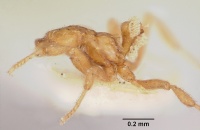Strumigenys filitalpa
| Strumigenys filitalpa | |
|---|---|

| |
| Scientific classification | |
| Kingdom: | Animalia |
| Phylum: | Arthropoda |
| Class: | Insecta |
| Order: | Hymenoptera |
| Family: | Formicidae |
| Subfamily: | Myrmicinae |
| Tribe: | Attini |
| Genus: | Strumigenys |
| Species: | S. filitalpa |
| Binomial name | |
| Strumigenys filitalpa (Brown, 1950) | |
Brown (1964) - A single worker taken under a stone bordering the lawn at the Main Lodge, Brown County State Park, Indiana. Some of the clypeal hairs are curved slightly laterad as well as forward, but all are very fine, as in the holotype, and other characters agree well. The holotype, the only previously known specimen of the species, came from Pike Co., Arkansas.
Identification
Bolton (2000) - A member of the Strumigenys talpa-group. Most specimens examined have all hairs on the leading edge of the scape curved toward the scape apex, but a few have 1-2 curved toward the scape base. Because material of this species is so sparse I am unable to tell if this is normal variation or the result of hairs having been displaced during mounting, though I suspect the latter. For this reason filitalpa is run out twice in the key. See also under Strumigenys talpa.
Keys including this Species
Distribution
Latitudinal Distribution Pattern
Latitudinal Range: 34.8° to 34.8°.
| North Temperate |
North Subtropical |
Tropical | South Subtropical |
South Temperate |
- Source: AntMaps
Distribution based on Regional Taxon Lists
Nearctic Region: United States (type locality).
Distribution based on AntMaps
Distribution based on AntWeb specimens
Check data from AntWeb
Countries Occupied
| Number of countries occupied by this species based on AntWiki Regional Taxon Lists. In general, fewer countries occupied indicates a narrower range, while more countries indicates a more widespread species. |

|
Estimated Abundance
| Relative abundance based on number of AntMaps records per species (this species within the purple bar). Fewer records (to the left) indicates a less abundant/encountered species while more records (to the right) indicates more abundant/encountered species. |

|
Biology
Castes
Nomenclature
The following information is derived from Barry Bolton's Online Catalogue of the Ants of the World.
- filitalpa. Smithistruma (Smithistruma) filitalpa Brown, 1950b: 39, pl. 3, fig. 4 (w.) U.S.A. Combination in Pyramica: Bolton, 1999: 1673; in Strumigenys: Baroni Urbani & De Andrade, 2007: 120. See also: Brown, 1953g: 79; Bolton, 2000: 132.
Unless otherwise noted the text for the remainder of this section is reported from the publication that includes the original description.
Description
Worker
Holotype. Total length (TL) 2.06 mm., head length (HL) 0.54 mm., length of alitrunk (WL) 0.52 mm., cephalic index (CI) 66, mandibulo-cephalic index (MI) 17. Similar to talpa, but perhaps a little more slender than is usual in the common species. Clypeus extremely slightly broader than long, opaque, differing from that of talpa in its pilosity, which is slightly longer, more abundant, and with the individual hairs clearly more slender, weaker, and not having their apices enlarged at magnifications of 60X-120X. The fringing hairs are curved weakly anteromedially; those on the surface of the disc are evenly distributed, weakly arched-subreclinate, nearly or quite as long as the fringing hairs. Hairs on the verticocciput stouter, more nearly clavate or spatulate and more erect than in talpa. Lateral borders of occipital lobes each with two long outstanding weak fiagelliform hairs.
Pronotum in profile shallowly but distinctly concave, meeting the mesonotum through an obtusely rounded angle. Median pronotal carina very indistinct, but continued a bit more distinctly on the mesonotum. The feebly concave parts of the pronotum with sculpture more or less effaced, so that large areas of the pronotal dorsum appear smooth and shining, as is also the case with the petiolar node. Basal costulae of gaster shorter than in talpa, extending not quite % the length of the basal tergite. Color light ferrugineous.
Bolton (2000) - TL 2.1, HL 0.54, CI 66, MI 17, AL 0.52. Closely related to Strumigenys talpa but fringe of hairs on lateral clypeal margin weak and filiform, only weakly curved anteriorly. Hairs on clypeal dorsum similar to those on lateral margin and nearly as long. Dorsolateral margin of head with 2 long flagellate hairs. Basigastral costulae extend only about one-quarter the length of the tergite.
Type Material
Bolton (2000) - Holotype worker, U. S.A. Arkansas, Pike Co. (W.F. Turner) (National Museum of Natural History) [examined].
References
- Baroni Urbani, C. & De Andrade, M.L. 2007. The ant tribe Dacetini: limits and constituent genera, with descriptions of new species. Annali del Museo Civico di Storia Naturale “G. Doria” 99:1-191.
- Bolton, B. 1999. Ant genera of the tribe Dacetonini (Hymenoptera: Formicidae). J. Nat. Hist. 3 33: 1639-1689 (page 1673, Combination in Pyramica)
- Bolton, B. 2000. The ant tribe Dacetini. Memoirs of the American Entomological Institute. 65:1-1028. (page 132, catalogue)
- Brown, W. L., Jr. 1950d. Preliminary descriptions of seven new species of the dacetine ant genus Smithistruma Brown. Trans. Am. Entomol. Soc. 76:37-45. (page 39, pl. 3, fig. 4 worker described)
- Brown, W. L., Jr. 1964b. The ant genus Smithistruma: a first supplement to the World revision (Hymenoptera: Formicidae). Transactions of the American Entomological Society. 89:183-200.
- Carroll, T.M. 2011. The ants of Indiana (Hymenoptera: Formicidae). M.S. thesis, Purdue University.
References based on Global Ant Biodiversity Informatics
- Brown W. L. 1964. The ant genus Smithistruma: a first supplement to the world revision (Hymenoptera: Formicidae). Transactions of the American Entomological Society 89: 183-200.
- Carroll T. M. 2011. The ants of Indiana (Hymenoptera: Formicidae). Master's Thesis Purdue university, 385 pages.
- Coovert, G.A. 2005. The Ants of Ohio (Hymenoptera: Formicidae) Ohio Biological Survey Bulletin New Series Volume 15(2):1-196
- Munsee J. R. 1968. Nine species of ants (Formicidae) recently recorded from Indiana. Proc. Indiana Acad. Sci. 77: 222-227.

